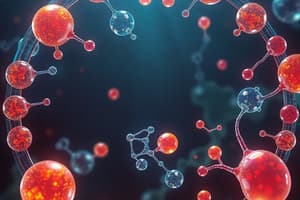Podcast
Questions and Answers
Which feature is characteristic of proteins that distinguishes them from carbohydrates?
Which feature is characteristic of proteins that distinguishes them from carbohydrates?
- Exist as polymers
- Function as energy storage
- Composed of sugars
- Composed of amino acids (correct)
What is the primary role of nucleic acids in cellular biology?
What is the primary role of nucleic acids in cellular biology?
- Structural components
- Energy storage
- Protein synthesis (correct)
- Signal transduction
Which statement correctly describes the structure of carbohydrates?
Which statement correctly describes the structure of carbohydrates?
- Composed of nucleotides in a double helix
- Made up of monosaccharides, disaccharides, or polysaccharides (correct)
- Form rigid structures only in animal tissues
- Always exist as long chains of amino acids
Which of the following factors can directly influence the activity of enzymes?
Which of the following factors can directly influence the activity of enzymes?
What distinguishes saturated fats from unsaturated fats?
What distinguishes saturated fats from unsaturated fats?
What is catabolism primarily responsible for?
What is catabolism primarily responsible for?
Which cellular structure is directly involved in ATP production?
Which cellular structure is directly involved in ATP production?
In what way do operons influence gene expression?
In what way do operons influence gene expression?
Flashcards are hidden until you start studying
Study Notes
Overview of Biochemistry
- Biochemistry is the branch of science that explores the chemical processes within and related to living organisms.
- It bridges the gap between biology and chemistry, focusing on molecular mechanisms.
Key Biomolecules
-
Carbohydrates
- Composed of sugars and starches.
- Functions: energy storage, structural components (e.g., cellulose in plants).
- Types: monosaccharides (glucose), disaccharides (sucrose), polysaccharides (glycogen).
-
Proteins
- Composed of amino acids.
- Functions: catalysts (enzymes), structural components, signaling molecules (hormones).
- Structure: primary (amino acid sequence), secondary (alpha-helix, beta-sheet), tertiary (3D shape), quaternary (multiple polypeptide chains).
-
Lipids
- Includes fats, oils, and phospholipids.
- Functions: energy storage, cellular membrane structure, signaling.
- Types: saturated fats (solid at room temperature) and unsaturated fats (liquid at room temperature).
-
Nucleic Acids
- DNA and RNA, composed of nucleotides.
- Functions: genetic information storage (DNA), protein synthesis (RNA).
- Structure: DNA (double helix), RNA (single strand).
Metabolism
- Catabolism: breakdown of molecules to produce energy (e.g., glycolysis, Krebs cycle).
- Anabolism: synthesis of complex molecules from simpler ones (e.g., protein synthesis).
- ATP (adenosine triphosphate) is the primary energy currency of the cell.
Enzymes
- Biological catalysts that speed up chemical reactions.
- Characteristics:
- Specificity: enzymes work on specific substrates.
- Active site: region where substrate binds.
- Factors affecting activity: temperature, pH, and substrate concentration.
Cellular Structures
- Membranes: lipid bilayer structure that acts as a barrier and site for biochemical processes.
- Organelles: specialized structures, such as:
- Mitochondria: ATP production.
- Ribosomes: protein synthesis.
- Endoplasmic reticulum: synthesis of proteins (rough ER) and lipids (smooth ER).
Genetic Information
- Gene expression involves transcription (DNA to RNA) and translation (RNA to protein).
- Regulation is crucial for cellular function and includes mechanisms like operons and feedback inhibition.
Metabolic Pathways
- Series of enzymatic reactions that convert substrates into products.
- Pathways can be linear, branched, or cyclic (e.g., the citric acid cycle).
- Regulation of pathways ensures cellular balance and efficiency.
Applications
- Medicine: understanding diseases at a molecular level; drug design.
- Biotechnology: genetic engineering, production of biopharmaceuticals.
- Agriculture: creation of genetically modified organisms (GMOs) for improved yield and resistance.
Importance
- Provides insight into how life works at a molecular level.
- Aids in the development of new technologies and treatments in healthcare and agriculture.
Biochemistry Overview
- The study of chemical processes within and related to living organisms.
- Bridges the gap between biology and chemistry
- Focuses on molecular mechanisms
Key Biomolecules
- Carbohydrates:
- Composed of sugars and starches.
- Functions: energy storage, structural components (e.g., cellulose in plants).
- Types: monosaccharides (glucose), disaccharides (sucrose), polysaccharides (glycogen).
- Proteins:
- Composed of amino acids.
- Functions: catalysts (enzymes), structural components, signaling molecules (hormones).
- Structure: primary (amino acid sequence), secondary (alpha-helix, beta-sheet), tertiary (3D shape), quaternary (multiple polypeptide chains).
- Lipids:
- Include fats, oils, and phospholipids.
- Functions: energy storage, cellular membrane structure, signaling.
- Types: saturated fats (solid at room temperature) and unsaturated fats (liquid at room temperature).
- Nucleic Acids:
- DNA and RNA, composed of nucleotides.
- Functions: genetic information storage (DNA), protein synthesis (RNA).
- Structure: DNA (double helix), RNA (single strand).
Metabolism
- Catabolism: breakdown of molecules to produce energy (e.g., glycolysis, Krebs cycle).
- Anabolism: synthesis of complex molecules from simpler ones (e.g., protein synthesis).
- ATP (adenosine triphosphate) is the primary energy currency of the cell.
Enzymes
- Biological catalysts that speed up chemical reactions.
- Characteristics:
- Specificity: enzymes work on specific substrates.
- Active site: region where substrate binds.
- Factors affecting activity: temperature, pH, and substrate concentration.
Cellular Structures
- Membranes: lipid bilayer structure that acts as a barrier and site for biochemical processes.
- Organelles: specialized structures, such as:
- Mitochondria: ATP production.
- Ribosomes: protein synthesis.
- Endoplasmic reticulum: synthesis of proteins (rough ER) and lipids (smooth ER).
Genetic Information
- Gene expression involves transcription (DNA to RNA) and translation (RNA to protein).
- Regulation is crucial for cellular function and includes mechanisms like operons and feedback inhibition.
Metabolic Pathways
- Series of enzymatic reactions that convert substrates into products.
- Pathways can be linear, branched, or cyclic (e.g., the citric acid cycle).
- Regulation of pathways ensures cellular balance and efficiency.
Applications
- Medicine: understanding diseases at a molecular level; drug design.
- Biotechnology: genetic engineering, production of biopharmaceuticals.
- Agriculture: creation of genetically modified organisms (GMOs) for improved yield and resistance.
Importance
- Provides insight into how life works at a molecular level.
- Aids in the development of new technologies and treatments in healthcare and agriculture.
Studying That Suits You
Use AI to generate personalized quizzes and flashcards to suit your learning preferences.



